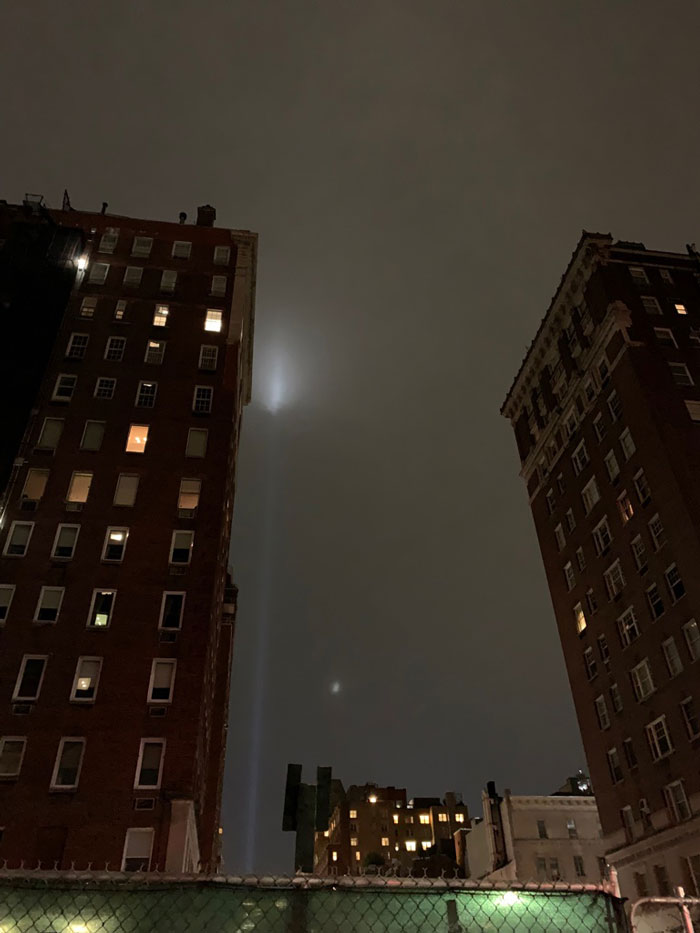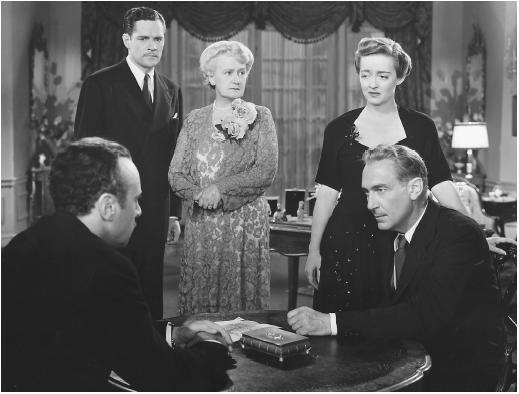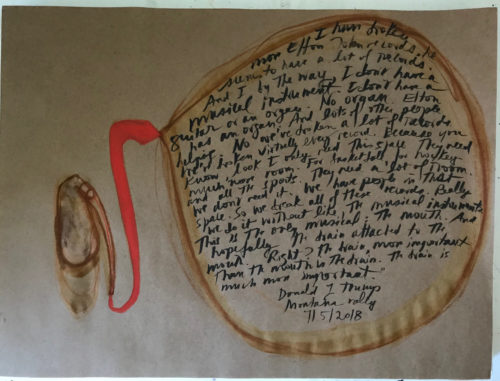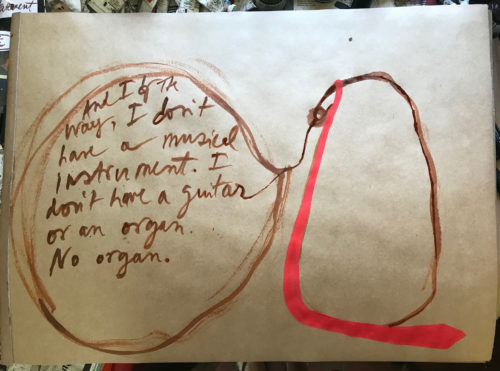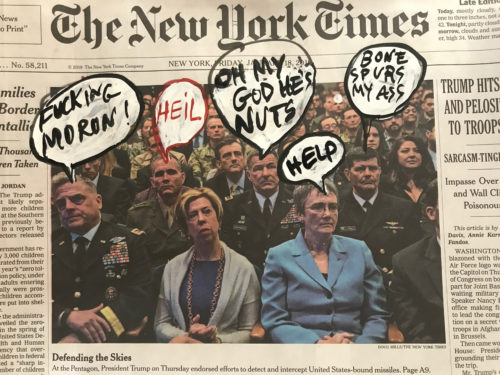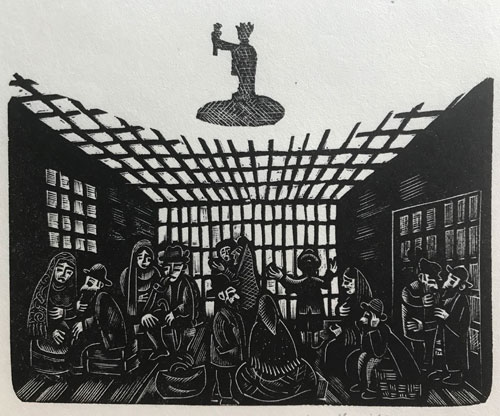As the Democratic field gets more and more crowded, and trump gets more and more clinically insane and politically dangerous, the anxiety level just rises.
My initial thoughts: Any Democrat is better than any Republican at this point in time. There is a difference between the parties, even when the Democratic Party is at its most conservative. Get real: In terms of Justices, not just SCOTUS but at the level below, it is a national emergency though of course my ideal candidate would be a progressive with the ability to communicate convincingly to a wide electorate, because it is important to provide a vision different than the one that got us to being so vulnerable to the current disaster and because some truth telling is in order: sappy “all we need is love” or “this is not who we are” type statements need to be buttressed by what we are or should be: a country of immigrants that has been enriched, literally, by immigration, for example, a country that understands we exist on a small planet–basic things like that.
It goes without saying that any pandering to the trump base is out of the question from my point of view. There is much more purchase in inspiring young voters, in keeping the activists who helped create the 2018 congressional sweep interested, while giving lifelong Democratic Party voters renewed enthusiasm.
Given that, first of all I feel that anyone who would be close to 80 at the beginning of their term is simply too old physically and also in their ability to deal best with contemporary challenges, even if they are in the vanguard of old progressive politics (Sanders). Thus no country for old men right now, Sanders and Biden, NO, please please don’t run. They also are both problematic for women who for various reasons feel it’s time for a woman. They each carry baggage on that score that can’t be erased.
As a warning, I would bring up the story of Elizabeth Holzman’s 1980 campaign for the Senate:
“In the general election, Holtzman faced Republican nominee Alfonse D’Amato and incumbent Senator Jacob Javits. After losing to D’Amato in the Republican primary, Javits ran on the Liberal Party ticket. He retained his union endorsements and drew liberal and Jewish voters away from Holtzman.[ A theme of D’Amato’s campaign was that Holtzman had never voted for a Department of Defense appropriation bill in Congress.D’Amato won the election by a margin of 1%, or 81,000 votes, over Holtzman.” [from Wikipedia]
FYI: JAVITS WAS 76 AND HAD A DISTINGUISHED CAREER BEHIND HIM AS A LIBERAL REPUBLICAN WHEN HE LOST THE REPUBLICAN PRIMARY, AND AGAINST ADVICE AND PLEAS RAN A SPOILER’S RACE THAT STUCK US WITH D’AMATO FOR THREE TERMS AND DAMAGED HOLTZMAN’S NATIONAL AMBITIONS PERMANENTLY. IT WAS A TOTAL VANITY RUN AND HE MAY ALSO HAVE ALREADY BEEN SICK WITH THE MYESTHENIA GRAVIS THAT HE DIED FROM A FEW YEARS LATER. SO NO COUNTRY FOR OLD MEN PLEASE. **And no billionaires please.** And sorry, no Clinton, for the age and for the baggage. She won the popular vote, she would have been a decent normal president. But times change and I think some freshness is required. And practically speaking, keep in mind there are fewer financial resources for Democratic Party candidates, so vanity candidates will siphon off important resources.
Another no: please not Beto O’Rourke. I was electrified by his visits to immigration detention centers at the border in June. For the clarity and passion of his presence and his comments at that moment, I am grateful to him. I donated to his campaign, I wish he had won the Senate race in Texas. I’m even marginally interested in what he is doing right now driving around the country, but it seems more of a kind of art work, a performance piece that may develop into a mature political identity or something else. So, I don’t think so, even though he meets the longing for a Jimmy Stewart Mr. Smith Goes to Washington type of guy, a young white hope. NO, not now.
Of the candidates who have already announced, I find the three top women qualified and effective each in their own way. Compared to any Republican each would be fine. I mean, that’s not saying much since trump has buried the bar in the lower depths of hell. However here are some of my preliminary views with some reservations.
I feel that Warren, who is a good communicator and feisty in a good way, is stuck with her basic views on economics and doesn’t make the broader connection for the American people that would be so important, the link between current tax policy favoring the rich and all the other anti-middle class and poor and pro-super rich GOP policies, with the country’s inability to invest in schools, roads, new technologies. She needs her message to get bigger.
I never trust Kirsten Gillibrand–there’s her early support of the NRA, and her role in the Al Franken affair, which still rankles. But then I listen to her and she can be surprisingly effective and might have appeal with the electorate beyond New York State. I think she shouldn’t be underestimated. I also always wonder if I don’t discriminate against her because of her girlish looks and voice.
(though speaking of voice, is it too much to ask for someone who didn’t yell at us..not just Sanders and trump of course, but also Andrew Cuomo, god what a nightmare)
Kamala Harris is a strong candidate. She exudes the aura that she can do it, she can take it. She has the energy and just the requisite amount of experience and freshness. However for all that I was a bit disappointed with her in the Judiciary hearings this fall, where she would seem to be moving in for the kill and then not do it, for reasons unknown to me (for example she must have known that Kavanaugh had watched Blasey Ford’s testimony when she asked him if he had, no prosecutor would go fishing without having the info, so she got him to lie, but then didn’t tell him there was evidence he had watched. Why not? Still don’t get that). I think that Rachel Maddow picked up on her strengths and appeal when Maddow somewhat surprisingly and it seemed to me very prematurely and possibly unethically put her imprimatur on Harris’s campaign for the nomination.
Cory Booker has the best announcement video, out today, incredibly well put together. He’s likable and he’s been smart about supporting other Democrats around the country, but he seems a bit of a lightweight, and he has pro-Pharma and other reactionary history, and while I respect his privacy about his personal life, I wonder if that very discretion won’t be a liability in the glare of a national campaign.
There are a couple of other candidates or near candidates I just don’t know enough about, and then there is the one who is considering but so far holding back from announcing a run and that is Senator Amy Klobuchar. I think of her as the Angela Merkel of the field. I think her placement in the mid-West and her ability to win by huge margins in a conservative area is strong and her speech at the Kavanaugh hearings was a knock-out. I am not utterly convinced by “Minnesota nice”– I mean I think it is authentic to her but we need an avenger also–so I would hope she would show also more of the toughness of that speech and also use her Minnesota nice to move slightly to the left in terms of some policy.
Sherrod Brown is another mid-Western nice, he’s making some going to Iowa gestures, he’s OK, but I’d rather Klobuchar and she has better winning percentages.
I also think of the very talented women who are not positioned to run for President in this cycle, Stacey Abrams for example, and hope we see their candidacies in the next cycle. I hope Rep. Alexandria Ocasio-Cortez matures into a potential candidate. She’s brilliant, but she’s 29 and has been in public office for a month, let’s take a deep breath. But a Democrat has to win in 2020 for us even to think we’ll have anything like real elections in the future.
Another point: I’ve noticed on Facebook posts by men, many are happy to put together tickets where the female candidates or possible candidates (Klobuchar) are always in the VP position. I don’t see a single one of those women choosing that as a viable alternative to being a Senator. It is more the patient white man’s long game. These women are going for the top position now.
The question of who can win, winability, is misplaced: character and general affect are important certainly, but the new formula, for worse (the current occupier of the White House) or for better, Rep. Alexandria Ocasio-Cortez, is that a candidate who is able to speak with truth and conviction about policies that maybe branded as radical can win in the current atmosphere. Be truthful and positive. And someone has to be the adult in the room.
Finally I would wish for the contemporary equivalent of Abraham Lincoln or Franklin Delano Roosevelt. Both were very good politicians, and/but also had good politics, good instincts, instilled enthusiasm and courage. They arose in the greatest moments of crisis in our history and were able to use both sides of their personality to bring us through. We are in another great moment of crisis. I’m not sure if any of these candidates has that inner core but all are decent enough. We’ll see. I think for someone to put themselves through such a brutal process they have to have what it takes to win, but one also hopes for a sense of destiny, not of entitlement but of generosity of spirit, something that I think Obama had and was able to exude. They have to have a personal sense of destiny that you are the one to take on the challenges of your country at that moment.
If we can’t defeat this creature from the depths of hell who has invaded our country and is destroying it daily, then fuck us.
